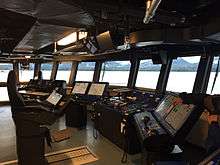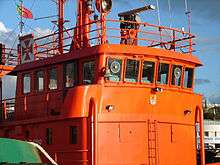Bridge (nautical)
The bridge of a ship is the room or platform from which the ship can be commanded. When a ship is under way, the bridge is manned by an officer of the watch aided usually by an able seaman acting as lookout. During critical maneuvers the captain will be on the bridge, often supported by an officer of the watch, an able seaman on the wheel and sometimes a pilot, if required.

Evolution


Traditionally, sailing ships were commanded from the quarterdeck, aft of the mainmast, where the ship's wheel was located (as it was close to the rudder). With the arrival of paddle steamers, engineers required a platform from which they could inspect the paddle wheels and where the captain's view would not be obstructed by the paddle houses. A raised walkway, literally a bridge, connecting the paddle houses was therefore provided. When the screw propeller superseded the paddle wheel, the term "bridge" survived.[1]
Wheelhouses were a small enclosure around the ship's wheel on the quarter deck of sailing ships. On modern ships the wheelhouse or pilothouse refers to the bridge of smaller motor vessels, such as tugs.[1]
Traditionally, commands would be passed from the senior officer on the bridge to stations dispersed throughout the ship, where physical control of the ship was exercised, as technology did not exist for the remote control of steering or machinery. Helm orders would be passed to an enclosed wheel house, where the coxswain or helmsman operated the ship's wheel. Engine commands would be relayed to the engine officer in the engine room by an engine order telegraph that displayed the captain's orders on a dial. The engine officer would ensure that the correct combination of steam pressure and engine revolutions were applied. The bridge was often open to the elements, therefore a weatherproof pilot house could be provided, from which a pilot, who was traditionally the ship's navigating officer, could issue commands from shelter.[1]
Iron, and later steel, ships also required a compass platform. This was usually a tower, where a magnetic compass could be sited far away as possible from the ferrous interference of the hulk of the ship. Depending upon the design and layout of a ship, all of these terms can be variously interchangeable. Many ships still have a flying bridge, a platform atop the pilot house, open to weather, containing a binnacle and voice tubes to allow the conning officer to direct the ship from a higher position during fair weather conditions.[1]
Larger ships, particularly warships, often had a number of different bridges. A navigation bridge would be used for the actual conning of the ship. A separate admiral's bridge could be provided in flagships, where the admiral could exercise strategic control over his fleet without interfering with the Captain's tactical command of the vessel. In older warships, a heavily armored conning tower was often provided, where the vital command staff could be located under protection to ensure that the ship could be commanded under fire.[2]
Configuration

.jpg)
Modern advances in remote control equipment have seen progressive transfer of the actual control of the ship to the bridge. The wheel and throttles can be operated directly from the bridge, controlling often-unmanned machinery spaces. Aboard modern warships, navigational command comes from the bridge, whereas electronically directed weapon systems are usually controlled from an interior compartment.[2]
On a commercial vessel, the bridge will contain the equipment necessary to safely navigate a vessel on passage. Such equipment will vary with ship type, but generally includes a GPS navigation device, a Navtex receiver, an ECDIS or chart system, one or more radars, a communications system (including distress calling equipment), engine (telegraph) controls, a wheel/autopilot system, a magnetic compass (for redundancy and cross check capability) and light/sound signalling devices.[3]
Bridge wing
A bridge wing is a narrow walkway extending from both sides of a pilothouse to the full width of a ship or slightly beyond, to allow bridge personnel a full view to aid in the maneuvering of the ship.[4] Officers use bridge wings when docking or maneuvering in locks and narrow waterways. Each bridge wing may be equipped with a console controlling the bow thruster, stern thruster, rudder and engines.[5]
Navigation station

The navigation station of a ship may be located on the bridge or in a separate chart room, nearby. It includes a table sized for nautical charts where calculations of course and location are made. The navigator plots the course to be followed by the ship on these charts.[6] Besides the desk and the navigation charts, the area contains navigational instruments that may include electronic equipment for a Global Positioning System receiver and chart display, fathometer, a compass, a marine chronometer, two-way radios, and radiotelephone, etc.[7]
See also
References
- Woodman, Richard (2012). The History of the Ship: The Comprehensive story of seafaring from the earliest times to the present day. Bloomsbury Publishing. p. 352. ISBN 9781844862108.
- McLeod, Iain; Smeal, Derek (2001), "Integrated platform management system design for future naval warships", in Noyes, Jan; Bransby, Matthew (eds.), People in Control: Human Factors in Control Room Design, Control, Robotics and Sensors Series, Institution of Electrical Engineers, p. 315, ISBN 9780852969786
- Macneil, Iain (2015). 21st Century Seamanship. Edinburgh: Witherby Publishing Group.
- Maritime and Coastguard Agency (Great Britain) (2002), "V", Safety of Navigation: Implementing SOLAS, London: The Stationery Office, p. 214, ISBN 9780115525759
- House, David\ (2007). Ship Handling. London: Routledge. p. 288. ISBN 9781136366574.
- Tracy, Jane (June 1989). "Summer editions". Cruising World. Newport, Rhode Island: New York Times Company. 15 (6): 89. ISSN 0098-3519. Retrieved 2018-01-06.
- Payne, John C. (1998). The Marine Electrical and Electronics Bible. Maintenance and Repair. Sheridan House. pp. 420. ISBN 9781574090604.
Navigation station.
External links
| Wikimedia Commons has media related to Bridges (nautical). |